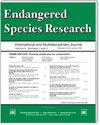内分泌数据进一步证明,受深水地平线漏油事件影响的海龟出现了生理失调
IF 2.9
2区 环境科学与生态学
Q2 BIODIVERSITY CONSERVATION
引用次数: 0
摘要
摘要:本研究旨在描述受深水地平线漏油事件影响的坎普脊海龟(Lepidochelys kempii)的肾上腺皮质和甲状腺状况。针对 L. kempii 的血浆醛固酮检测方法已通过验证,该方法与之前通过验证的皮质酮和游离甲状腺素检测方法一起用于评估 30 只因接触油类而住院的 L. kempii 的激素浓度,这 30 只海龟代表了两种严重程度的油污(轻度油污或重度油污)。还结合 8 种临床生化分析物评估了激素浓度。对配对样本的分析表明,油龟的初始醛固酮和皮质酮浓度明显较高,但在康复期间有所下降(平均降幅分别为 96% 和 90%)。甲状腺素浓度在入院和康复期间明显增加(平均增加 65%)。最初的生化数据显示,血浆钾、离子镁和乳酸浓度明显高于康复值。醛固酮浓度与皮质酮呈正相关,与游离甲状腺素呈负相关,与几种临床生化分析指标呈不同程度的相关。本研究结果表明,无论涂油程度如何,在涂油、捕获和运送到医院后,L. kempii 的肾上腺皮质活性都很强,导致血浆中的醛固酮和皮质酮浓度非常高。这项研究还证实,可以在海龟血浆样本中可靠地测量醛固酮,为这一极度濒危物种的生理评估提供了另一种诊断工具。本文章由计算机程序翻译,如有差异,请以英文原文为准。
Endocrine data provide further evidence of physiologic derangement in sea turtles affected by the Deepwater Horizon oil spill
ABSTRACT: This study was conducted to characterize the adrenocortical and thyroid status of Kemp’s ridley sea turtles Lepidochelys kempii that were affected by the Deepwater Horizon oil spill. A plasma aldosterone assay was validated for L. kempii, and it was used along with previously validated assays for corticosterone and free thyroxine to assess hormone concentrations of 30 L. kempii that were hospitalized due to oil exposure, representing 2 severities of oiling (lightly or heavily oiled). Hormone concentrations were also assessed in relation to 8 clinical biochemical analytes. Analysis of paired samples indicated that oiled turtles had significantly higher initial aldosterone and corticosterone concentrations, which declined during convalescence (average 96 and 90% decrease, respectively). Thyroxine concentrations significantly increased between admission and convalescence (average 65% increase). Initial biochemical data indicated significantly higher plasma potassium, ionized magnesium, and lactate concentrations compared to convalescent values. Aldosterone concentrations were positively correlated with corticosterone, negatively correlated with free thyroxine, and variably correlated with several clinical biochemical analytes. Results of this study indicate that L. kempii had robust adrenocortical activity after oiling, capture, and transport to the hospital, regardless of the degree of oiling, resulting in very high plasma concentrations of aldosterone and corticosterone. This study also confirms that aldosterone can be reliably measured in sea turtle plasma samples, providing another diagnostic tool for the physiologic assessment of this Critically Endangered species.
求助全文
通过发布文献求助,成功后即可免费获取论文全文。
去求助
来源期刊

Endangered Species Research
BIODIVERSITY CONSERVATION-
CiteScore
5.50
自引率
6.50%
发文量
38
审稿时长
31 weeks
期刊介绍:
ESR is international and interdisciplinary. It covers all endangered forms of life on Earth, the threats faced by species and their habitats and the necessary steps that must be undertaken to ensure their conservation. ESR publishes high quality contributions reporting research on all species (and habitats) of conservation concern, whether they be classified as Near Threatened or Threatened (Endangered or Vulnerable) by the International Union for the Conservation of Nature and Natural Resources (IUCN) or highlighted as part of national or regional conservation strategies. Submissions on all aspects of conservation science are welcome.
 求助内容:
求助内容: 应助结果提醒方式:
应助结果提醒方式:


